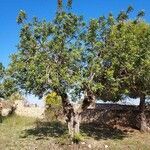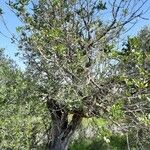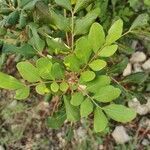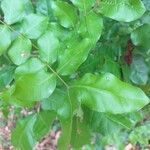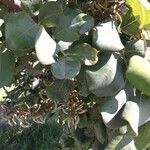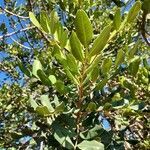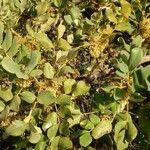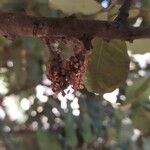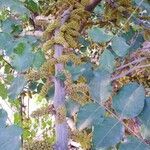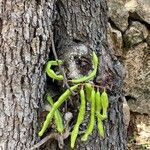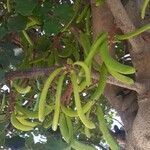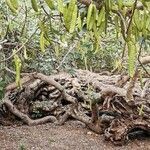An evergreen tree. It grows 12-15 m tall. It spread to 4 m across. It has a dark green round crown of compound leaves. These almost hide the trunk. The trunk is short, erect and thick. The leaves are leathery. The tree flowers in autumn. Male and female flowers are on separate trees. They grow in flower clusters on the previous year's growth. The flowers are small and red. The pods develop in spring. The flat pods are 30 cm long and 2.5 cm wide. They are thick, brown rough and leathery. The seed are constant in size and were used for the carat weight (200 mg). There are several cultivated varieties.
Evergreen unarmed shrub or tree. Leaves simply pinnate; leaflets 2-8 pairs, coriaceous, elliptic to orbicular, 3-6 cm long, 2.5-4 cm wide, dark glossy green above, pale green below. Flowers unisexual or hermaphrodite, greenish, small, in dense many-flowered racemes which are axillary or arise from the older wood. Calyx caducous. Petals 0. Stamens 5, free, exserted. Pods dark brown, 10-30 cm long, 1.5-2.2 cm wide, laterally compressed, coriaceous, pulpy, many-seeded, indehiscent.
Dense, ornamental evergreen, unarmed shrub or tree, often monoecious, 1-13 m high. Leaves entire, simply pinnate. Leaflets 2-8 pairs, coriaceous. Stipules minute, caducous. Inflorescences dense, many-flowered racemes, axillary or often arising from old wood (cauliflorous). Flowers unisexual or bisexual, irregular, small. Calyx caducous. Petals absent. Stamens 5, free. Pod laterally compressed, coriaceous, many-seeded, indehiscent.
Trees, 15-16 m tall. Leaves 8-17 cm; leaflets 2-4 pairs, shiny, obovate or suborbicular, 3.5-5.5 × 3-3.5 cm, leathery, glabrous, lateral veins conspicuously raised, base cuneate or broadly cuneate, margin entire, apex rounded, emarginate, or conspicuously cordate depressed. Raceme with rachis densely yellowish brown pubescent. Flowers reddish. Legume curved, 10-25 × ca. 2.5 cm. Fl. Nov.
Evergreen dioecious tree; leaflets in 2-8 pairs, 3-6 x 2.5-4 cm, elliptic; flowers in racemes from axils and old nodes, small, without petals, stamens of male flowers on a broad disk, the tomentellous ovary in female flowers with an enlarged, sessile, grooved stigma; pods dark brown, leathery, 10-30 x 1.5-2.2 cm, laterally compressed, pulpy, indehiscent, many-seeded.
It is an evergreen tree.. Leaflets 2–8 pairs, coriaceous.. Small greenish ♂ ♀ or hermaphrodite flowers with no petals and 5 exserted stamens (in the ♂ and hermaphrodite) in usually short racemes which are axillary terminal or clustered on the older wood.. Thick coriaceous pulpy indehiscent pods 12–30 cm. long and 2 cm. thick.
